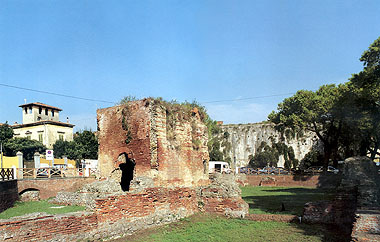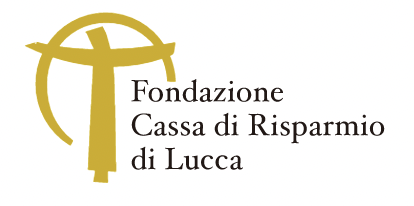
In recent years archaeological research has solved the long debated problem of the Ligurian or Etruscan origins of Pisa in favour of its ancient and unmistakable Etruscan character.
The settlement developed in a completely different environment than today, i.e. within an area marked by a coastal lagoon very near to the shore, taking advantage of the dunes and "tomboli" at the confluence of one of the Auser's branches with the Arno.
Since the Iron Age the area was settled by Villanovans who, during the Archaic Age, gave origin to the town. Its geographical position was particularly favourable for maritime trade and the early economic development of the town is confirmed by a great number of finds such as wine and oil amphorae or valuable pottery from southern Etruria or from the Greek world.
Therefore, at the end of the VIIth century B.C., the settlement of Pisa was already an economical, political as well as cultural reference for a vast area reaching inland to the lower course of the Arno and the Serchio valley and along the coast from Versilia to the shores of Livorno.
Pisa's prosperity and its important economic role continued along the Classic Age when the town increased its control of the surrounding territory occupying strategic positions with a system of highland settlements.
A crisis probably occurred between the end of the Vth and the IVth century B.C. when a large number of settlements on the territory rapidly declined. In the first decades of the IIIrd century B.C., Pisa entered into the orbit of Rome's interests and probably became one of her allies. The town's port certainly played a decisive role in Rome's expansion.
At the beginning of the Ist century B.C., after the civil wars, Pisa, like most Italian towns, became a municipium and obtained full citizenship within the tribe of Galeria.
Pisa's prosperity lasted in the following Imperial Age: its important port and complex system of maritime and fluvial landing-places, served land inward by easily navigable waterways like the Arno and the Auser, received goods from all over the Mediterranean and exported the agricultural and artisans' produce from a vast hinterland.
Details:
The foundation of the colony of veterans "Opsequns Iulia Pisana" between 41 and 27 B.C. led to a general rearrangement, drainage and partition of the territory (centuriazione) and certainly to changes in the urban pattern. Many scholars are of the opinion that on this occasion the plan of the town was completely renewed according to a regular pattern with perpendicular road axes, a pattern followed in part by the Medieval and Modern road network. Unfortunately the scanty archaeological records do not allow us to confirm the above conjecture nor to draw a consistent picture of the town in the Roman Age. The properly urban area, however, must have extended to the right bank of the Arno and the forum is unanimously placed in the area around Piazza dei Cavalieri.
Among the numerous civil and sacred buildings, the only complex that can still be seen today is that of the so called Bagni di Nerone ("Nero's Baths"), a thermal building dating back to the last two decades of the Ist century B.C. whose remains are near present day Porta a Lucca.
In the Ist century A. D. new docks were constructed around the river port of S. Rossore which at that time had already undergone a gradual process of filling up with earth, but certainly remained active until Late Antiquity as the considerable number of wrecks found there proves.
Private buildings are attested by remains of walls and pavements found in different parts of the present day town; among these are, in particular, pieces of mosaic from a domus that was excavated in the XIXth century in Piazza del Duomo. Inside or close to the town were also a number of ceramic factories producing the sigillata italica tableware for which Pisa was famous as one of the major production and export centres.
According to the most recent research it seems that Pisa assumed the character of a town in the last quarter of the VIIth century B.C.
The small Villanovan settlements, scattered in particular to the west, gradually become, during the first half of the VIIth century, more consistent nuclei with large open spaces between them, grouped, possibly, around the residences of nobles. Similarly, the contemporary necroplis recently discovered along via S. Jacopo with its large monumental tumulus surrounded by a series of smaller simpler tombs seems to reflect, in a funerary context, the social hierarchy of Etruscan society in its proto-urban phase.
From the last quarter of the VIIth and during the VIth century B.C., the inhabited area extends to the north of the present day course of the river Arno, a clear sign that the population was growing; sacred buildings like the one explored in Piazza del Duomo make their appearance; the dwellings evolve towards forms with regular plans and the use of tiles for roofing or, occasionally, as decorative elements in the architectures becomes widespread.
The fabric of the town in the Classic Age must not have been very different from that of the Archaic Age: the necropoleis continued to occupy a strip of land to the north, while in town some changes are apparent only from the late half of the Vth century B.C.
From the end of the IVth century B.C. a renewed drive to construct was probably accompanied by a considerable growth of the town's population, which during the following IIIrd century B.C. will lead to the occupation, for dwelling purposes, of surrounding areas formerly used as necropoleis: among these is the area next to the church of S. Zeno where, in particular, a neighbourhood of potters gradually develops.





